If you’re seeking an exotic locale for a snowshoe vacation, Nagano, Japan, offers shockingly beautiful frozen waterfalls, hot springs in the snow, snow monkeys in hot springs, traditional and modern accommodations, food from heaven, and unrivaled views of the Northern and Southern Japanese Alps. For these excellent points, Nagano hosted the XVIII Olympic Winter Games in 1998.
Nagano covers over 322 square miles of mostly mountainous terrain that includes almost 90 ski and snowboard resorts, countless cascading waterfalls and streams, and many thousands of choices for snowshoers. So where should you go if your vacation time is short? As a result of years of experience exploring its natural and semi-natural areas, my recommendations for newcomers to Nagano are Shirahone Onsen and Shiga Kogen.
Shirahone Onsen
Start your adventure with a journey to the bottom of a deep gorge surrounded by forests and steeply rising peaks to stay in an isolated village, whose name is Shirahone Onsen. The name means white bones. The thermal water issuing forth from the soil is soft, bone-white sulfurous water. Except for the addition of asphalt roads and the rebuilding of family homes and a dozen inns scattered along river banks or knolls, the village has not changed much in hundreds of years.
How To Get There:
A few buses and trains run to Shirahone Onsen from the nearest large city called Matsumoto, which is an hour away. Booking in advance is difficult for people who do not speak Japanese. Alpico Bus provides infrequent bus service directly from Matsumoto to Shirahone Onsen, and more frequent bus service from Shin-Shimashima Train Station, which is between Matsumoto and Shirahone Onsen. Click here for the bus schedule. Shirahone Onsen has two bus stops, one in the center of town and one in front of Awa no Yu, the town’s most renowned inn. For travel advice, you can contact English speakers at the Nagano City Tourist Information Center by phone (81 26-226-5626) or email (n-city@dia.janis.or.jp). Trains and buses from Nagano, Tokyo, and other major cities go to Matsumoto. You can rent a car and drive to Shirahone Onsen, but if you are not skilled at icy winter roads, don’t do it. You risk sliding off cliffs that edge the gorgeous but dangerous curving steep mountain roads on the route to the tiny village. Getting there may seem daunting, but the fantastic location enriches the journey.
Where To Stay:
The most famous of the village’s inns is Awa no Yu. You will likely meet the kimono-wearing manageress. Her family has been running Awa no Yu for 106 years.
Photographs of its outdoor bath have illustrated numerous books or magazines about secluded hot springs. This mixed-sex bath outside the hotel sits on a slope with lumpy pillows of snow around it. In the thick of winter, temperatures plunge so low that the wet hair on your head can freeze while your body submerged in the deep hot water stays comfortably warm. The natural outdoor bath with views of forests and mountains induces tranquility.
In touch with the modern sensibilities of many foreign guests, Awa no Yu provides women with big towels to cover their private body parts while soaking. Men, though, use a towel comparable in size to the average face towel in North America. Traditionally, both men and women used small towels.
When staying in Nagano, be open-minded to new experiences regarding bathing and eating. Awa no Yu serves gourmet dishes that might shock many Westerners. Sashimi in Nagano Prefecture includes the red meat of horse and the pink tissue of river fish. The fermented soybeans and some mushrooms that Japanese often eat are slimier than anything most North Americans enjoy. On the other hand, local dishes in Nagano include delicacies most Westerners appreciate: fresh soba noodles, soft and succulent wagyu, (“Japanese beef”), and locally made tofu and yogurt. Be sure to sample the crystal clear sake made with local rice and the water from snow-fed streams. If you are a vegetarian or have special food requests, contact Awa no Yu in advance.
While you are sampling a seemingly endless course of Japanese dinner treats, hotel staff will lay warm fluffy futon on the tatami floors of your room. Rooms face snowy wooded slopes. At night, if lucky, you might spot a fox seeking mice. While sipping hot Japanese tea in the morning, I noticed fresh fox footprints. I sighed happily, feeling refreshed and stimulated.
Snowshoeing near Shirahone Onsen:
Shirahone Onsen is a lovely and relaxing village for short walks in winter. You can visit different hotels and inns to try various baths, and you can snowshoe in some areas around town. However, cliffs surround much of the village. Go only where the locals tell you is safe. For longer snowshoe treks, drive about eight kilometers on a narrow road to Norikura Plateau. Snowshoe treks around Mt. Norikura are outstanding.
Most years, the snowshoeing season is from early December to the end of April. Mid-winter temperatures descend to lower than 10° below zero Celsius. For many snowshoe enthusiasts, Norikura’s most celebrated attractions are its many frozen waterfalls, especially Zengoro Falls.
To find Zengoro Falls, pick up a map at the information center, or stop at Little Peaks, an outdoor adventure store that offers guided snowshoe tours and also rents snowshoes to independent travelers. These facilities are in the same building in the town center. You cannot miss them.
A large sign points outs the trailhead to Zengoro Falls, and a giant wooden map displays all of the local trails and attractions. Sunken paths in the snow showed where previous hikers had gone. Norikura’s well-planned snowshoe routes allow hikers to enjoy new territory without the fear of getting lost, or accidentally running into a bear.
At intervals along the trail, you will see metal bars dangling from tree branches. Japanese kanji on the bars translate to this: “Be careful of bears.” Hit those bars together. The ringing informs bears in the area that hikers are on the path. The sound prevents accidental meetings and saves the lives of bears and humans.
After thirty minutes of passing over gently rounded white knolls, the path zigzagged into a sharp ravine. I could hear gurgling water before I saw a stream that sparkled in the rays of sunlight that passed between the snow-laden bending branches of birch and beech. We trod over a wooden bridge with piles of snow almost as high as the railing. Ahead of us, at the end of a u-shaped valley, standing over 20 meters high and almost as wide, Zengoro Falls grew out of the whiteness.
The natural ice sculpture made my wife, who was walking in lead position, appear minuscule. Winter had transformed the plunging waters of a mighty waterfall into a Disneyland-like castle of thick, barely translucent ice pillars and long, sharp icicles. The frozen giant exuded nature’s power. A thunderous clap of sound reverberated as ice shifted somewhere deep inside the frozen being’s interior. Then, a pure silence. Our eyes riveted on the waterfall, we noticed changing light patterns near the top. It was running water that was still plunging off the cliff under a wall of thick ice. Hoping that mid-winter temperatures would hold the ice in place, we walked along the base and climbed a small section before continuing our trek along our chosen route.
This route took us over a frozen pond, up and down rolling coconut-milk colored hills, along frozen cattle pasture, and past shrines and temples. We stopped at our leisure to examine unusual mushrooms, take photographs, slide on our butts down soft slopes, peer into animal holes in trees, and listen to bird calls. Our map indicated that a hotel was just a few hundred meters away from the path, and we were famished. We ordered a hearty meal of steamy soba and fresh tempura. Through the many windows of the hotel restaurant, we watched clouds gather near the top of Mt. Norikura.
Satisfied and refreshed, we attached our snowshoes to our boots and resumed our wonderful trek. The path eventually circled back to the knoll from which we began our hike. At one point, we spied Zengoro Waterfall from a higher elevation. Even from a kilometer or so away, it was still an impressive site. We took more photographs and drove our tired bodies back to Awa no Yu, where another delectable dinner and healing bath waited.
The next morning, we left Shirahone Onsen because my friends wanted to visit the famous bathing “snow monkeys” of Japan. We traveled for two and a half hours on smooth roads through sparsely populated scenic Nagano farmlands surrounded by mountains.
Snow Monkeys near Shiga Kogen
Semi-wild Japanese snow monkeys―macaques is the correct term―are a mesmerizing attraction. Free to come and go, they often spend their days in Jigokudani Yaen Park warming up in a hot spring. Countless media outlets, including National Geographic, have published stories about these memorable beings. Accustomed to camera-toting visitors, many will allow you to come within touching distance but don’t. They are still wild creatures.
During my first visit in mid-January a few years ago, subzero temperatures and a snowstorm dropping tons of powder kept the crowds away. The expected half-hour walk on an easy trail turned into a much longer snowshoe trek through thigh-high powder. My two companions and I were the only almost-hairless primates wandering amidst hundreds of furry ones. Doting mothers and tiny babies clung tightly together. Juvenile monkeys jumped, splashed, and chased each other. Elders with relaxed, contented expressions slowly stretched along the rims of the rocky bathtub.
In contrast, my visit in mid-March this year was zoo-like; twenty or more people aimed their cameras at three macaques lazily hanging around the bath. Hundreds of other macaques were foraging for food pellets in the snow, climbing trees, and playing, but the humans still outnumbered the macaques. The temperature, a few degrees above freezing, was not cold enough to entice the thick-furred primates into the hot springs. However, humans from all parts of the world had gathered with cell phones, video cameras, and cameras with gigantic telephoto lenses to capture their images.
The best times to catch bathing macaques are during the coldest winter days, especially when the park opens at nine a.m. Before going, you can check the live streaming “monkey cam” to learn if the snow monkeys are bathing or not.
Shiga Kogen
Jigokudani Yaen Park is a short drive by car or public bus from Shiga Kogen, a highland comprising five major mountains in northern Nagano Prefecture. That was our next destination. With altitudes ranging between 1,300 and 2,300 meters, Shiga Kogen boasts that it is the highest altitude ski resort and one of the biggest in Japan. Several Olympic events took place on those slopes. The United Nations Educational Scientific and Cultural Organization’s (UNESCO) counts Shiga Kogen and bordering areas as one part of its Man and the Biosphere Program, which aims to protect critical biological and physical features while promoting sustainability.
Snowshoeing Near Shiga Kogen:
Official and unofficial snowshoe routes stretch all over the region. The Shiga Kogen Nature Conservation Association offers treks led by certified guides. They say conditions are best in February. If you are confident enough to go on your own, many ski resorts and hotels rent snowshoes. We brought our own.
There were too many choices of trails, so upon arriving I sought advice from a front desk clerk and the manager at the Okushiga Kogen Hotel. Oku means farthest back, and kogen means highland. The Okushiga Kogen Hotel is one of the most remote hotels in Okushiga, and more snow accumulates there than in most other areas of Nagano. Following their helpful staff advice, we had three different, wonderful hikes close to the ski in/ski out, or (in our case) snowshoe in/snowshoe out, hotel.
The first hike was a twilight trek before dinner through a dimly lit forest within minutes from our rooms. It was a perfect way to sharpen our appetite for a gourmet dinner at the hotel.
The next day, we rode a small gondola to Mt. Yakebitai, (elevation 2,000 meters) where we walked up and down ridges between ski resorts. We found a small shrine nearly buried in snow, picnicked on a knoll with panoramic views of blue sky, volcanic mountain peaks, and highland trees, and then we returned by gondola after a refreshing coffee at a ski lodge. Along the trail, we were alone except for two hardy cross-country skiers.
For our last hike, we climbed up a nearby snowbank where a snowplow had ceased plowing, and we walked along a snakelike riverside road. Countless trees, singing birds, a cloudless sky, various animal tracks, and an ocean of snow surrounded us. Just another typical fantastic winter hike in Nagano Prefecture, Japan.
Additional Information for Shirahone Onsen
Location: Shirahone Onsen, Nagano Prefecture, Matsumoto, Japan
How to Get There: Book a flight to Matsumoto and bus ride through Alpico Bus, which provides infrequent bus service directly from Matsumoto to Shirahone Onsen, and more frequent bus service from Shin-Shimashima Train Station, which is between Matsumoto and Shirahone Onsen. Click here for the bus schedule. For travel advice, you can contact English speakers at the Nagano City Tourist Information Center by phone (81 26-226-5626) or email (n-city@dia.janis.or.jp).
Where to Stay: Awa no Yu
Recommended Snowshoe Trails: Mt. Norikura, specifically Zengoro Falls
Equipment Rentals: Little Peaks, which offers guided snowshoe tours and snowshoe rentals
Snowshoe Season: typically early December to end of April
Additional Information for Shiga Kogen
Location: Shiga Kogen, Nagano Prefecture, Japan
How to Get There: See access to Shiga Kogen
Where to Stay: Okushiga Kogen Hotel
Recommended Snowshoe Trails: Mt. Yakebitai and guided treks by Shiga Kogen Nature Conservation Association
Tour Options: Snow Monkey and Snow Tour in Shiga Kogen, which runs Jan 1- Mar 31
Snowshoe Season: typically early December to end of April, usually conditions best in Feb

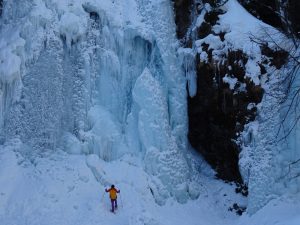
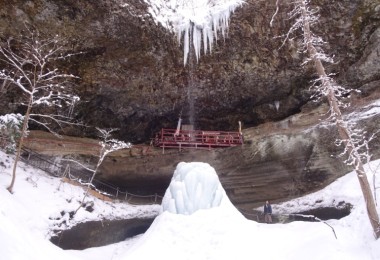
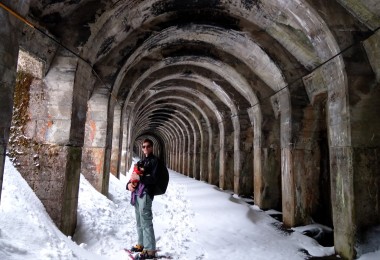
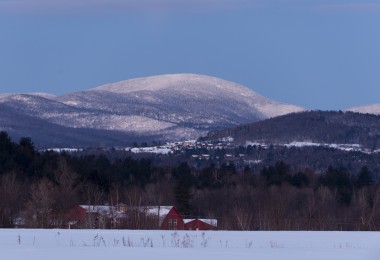
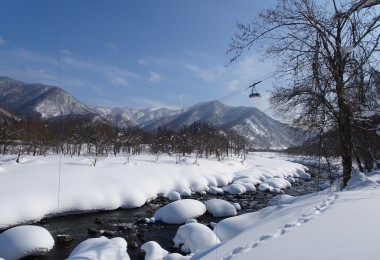

As I’ve never been to Japan before, can you recommend a nice snowshoe experience that would involve little travel hassle? Infrequent train or bus schedules seem way too difficult for the first time visitor. Thanks for your articles as they have really peaked my interest in trying snowshoeing in Japan.
Mark B
Hello Mark,
That is an excellent question. I just checked the Internet for a good answer. The location that I was thinking of suggesting is Myoko Kogen, which I have written about on this site. I discovered the following website. Near the bottom, there is a link to a bus service that will take guests from the Narita or Haneda, the two international airports near Tokyo, to various locations that are famous for skiing and great for snowshoeing, including Shigakogen. However, I have never used these services, so I cannot make any promises. http://myokokogen.net/getting-to-myoko-kogen/
Good article and an even better time being there! Thanks, Greg
You are welcome. Thanks for writing a comment.
I have also been to this location. Nagano is a dream location for snowshoeing.
Very well written, informative, and fascinating article.